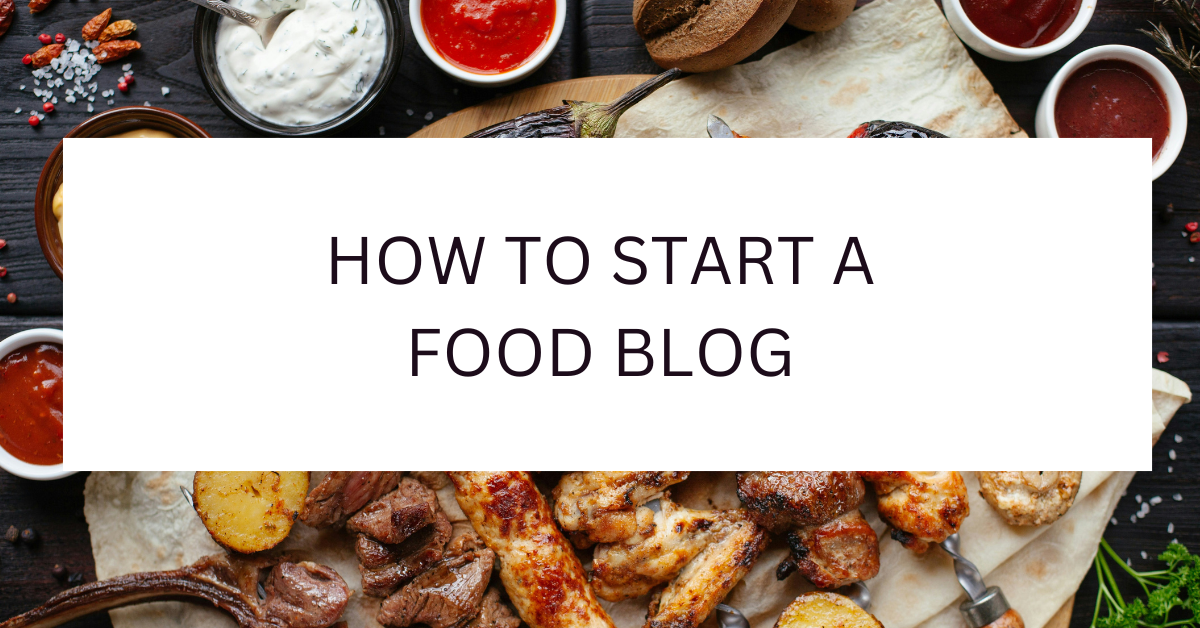How To Start A Food Blog
Are you a food enthusiast who is always eager to try new recipes and experiment with flavors? Starting a food blog is a fantastic way to showcase your culinary skills and love for food to the world.
With your unique perspective and delightful content, you can inspire others to explore the world of cooking, baking, and everything else that’s delicious.
But where do you begin? How can you transform your love of food into a prosperous online business? This comprehensive guide will take you on a mouthwatering journey, providing you with the essential ingredients to start your very own food blog.
Note: This post contains affiliate links, which means I earn a little when you purchase using these links at no additional cost to you.
What Is A Food Blog?
A food blog is a digital platform where individuals or groups share recipes, culinary tips, food photography, restaurant reviews, cooking videos, and other food-related content.
It serves as a community for food lovers, chefs, home cooks, and anyone interested in culinary arts. It provides a space to explore, learn, and exchange ideas about food and cooking.
How To Start A Food Blog
1. Finding Your Foodie Niche:
When it comes to food blogging, finding a unique culinary niche is a crucial step. It serves as the foundation upon which your blog is built, setting the stage for attracting a like-minded audience.
By identifying what sets you apart, you can establish yourself as a go-to resource within your community.
Take a moment to think about what sparks your love for cooking. Do you enjoy baking, experimenting with vegan cuisine, or exploring international flavors?
Remember, the world of food blogging is vast and varied, and finding your niche is about showcasing the flavors that resonate with you.
So, spend some time thinking about your favorite kitchen experiments, the recipes you’re most proud of, or the food stories that have shaped your cooking journey.
2. Choose A Domain Name:
Selecting the right domain name is crucial for establishing your online presence as a food blogger. Your web address is your invitation to the potential audience into the world of culinary delights.
When brainstorming for a domain name, choose something that is easy to remember, concise, and related to your food blogging niche.
Avoid complex spellings and consider including keywords related to your culinary focus to enhance discoverability. Use online tools and food blog name generators to help find an available name.
Reflect on potential food blog names that offer flexibility for future expansion into other food-related areas without limiting you to a specific genre.
Here is a list of 450+ Food Blog Name Ideas.
Having a name that aligns with your content and values strengthens your brand and makes it easier for your target audience to find and remember your blog.
3. Find A Web Host:
Finding a reliable web host provider is fundamental in bringing your food blog to life online. This web host provider will store your blog’s data, ensuring it’s accessible to visitors anytime.
There are many web hosting services available, ranging from those offering basic, cost-effective solutions for beginners to more advanced, feature-rich hosting for growing blogs.
Some of the top web hosting providers are DreamHost, Hostinger, and Hostgator.
When selecting a provider, consider factors such as uptime guarantees, customer support, scalability options, and the ability to handle traffic spikes.
Additionally, look for a web host with security features like SSL certificates to protect your site and visitors’ information. Evaluate different hosting plans to find one that suits your budget while meeting your technical requirements.
4. Install A Blogging Software:
After securing a domain name and selecting a web host provider, the next step is establishing a blogging platform.
The digital market offers various website-building platforms, such as WordPress, Blogger, and Squarespace, each with its own set of advantages.
| Platforms | Functionalities |
|---|---|
| WordPress.com | It is highly customizable, widely used, and comes with many plugins and themes. |
| WordPress.org | Easy website creation with stunning templates and built-in SEO features. |
| Blogger | This service is easy to use, offers free hosting, and is owned by Google. |
| Squarespace | Easy-to-use templates with built-in SEO. |
Many hosting plans offer one-click installation for WordPress.org, which can be helpful for new users without technical knowledge.
5. Pick A responsive theme:
Choosing the right theme for your food blog is crucial, as it significantly impacts how your content is presented and perceived by your audience.
A responsive theme adjusts your blog’s layout to fit any device screen for an optimal user experience.
When selecting a theme, look for one that not only resonates with your blog’s aesthetic but also highlights your culinary creations in the best possible light.
Themes with clean, minimalistic designs often allow your food photography to stand out, capturing your readers’ attention.
Ensure the theme you pick is regularly updated and supported by its developers to keep your blog running smoothly and securely.
Many bloggers use Astra and Elementor themes to create a better user experience.
6. Visual Appeal:
Food is as much about the visual experience as it is about taste. High-quality photos and videos are essential for a successful food blog.
Here are some tips to create a visually appealing food blog:
Invest in a good camera: While smartphone cameras can work, a DSLR or mirrorless camera gives you more control over depth of field and lighting, key components of drool-worthy food photography.
Natural light is your best friend: Whenever possible, use natural light. It enhances the colors and textures of your dishes, making them look more appealing.
Learn basic photography skills: Understanding the basics of composition, such as how to use exposure and focus properly.
Presentation matters: Before snapping pictures, take the time to style your dish. A little garnish or arranging your food artistically goes a long way.
Keep it real: While you want your dishes to look their best, ensure they still look edible and inviting. Avoid over-styling where the food seems artificial.
Try different techniques and styles to find what works best for you and resonates with your audience. Your unique voice and perspective will ultimately make your blog stand out.
7. Write & Publish Your First Post:
The key to a successful food blog is crafting appetizing content that satisfies your audience’s culinary cravings.
Dive deep into your unique culinary niche and offer fresh perspectives on recipes, insightful cooking techniques, and personal stories behind your dishes.
It is crucial to experiment with different content types, such as how-to guides, video tutorials, and interviews with culinary experts. The variety will appeal to a wide range of audiences.
Pay attention to the seasons, including timely recipes and topics, to keep your content relevant and exciting.
Encourage interaction by posing questions and inviting readers to share their experiences and tips in the comments section.
8. Master Search Engine Optimization (SEO):
Understanding the complex world of search engine optimization (SEO) is essential to enhance your food blog’s online presence.
Start by conducting keyword research to identify terms and phrases closely related to your culinary niche.
Incorporating these keywords into your blog posts, titles, and meta descriptions in a natural and meaningful way can significantly boost your search engine rankings, making it easier for potential readers to find your content.
Aside from that, focus on optimizing your blog’s loading speed and mobile responsiveness, as search engines consider these factors when determining rankings.
Engage in building quality backlinks by collaborating with other food bloggers or contributing guest posts to reputable food blogs.
These backlinks not only drive direct traffic to your blog but also signal to search engines that your content is valuable and trustworthy, further improving your SEO performance.
Keep in mind that SEO is an ongoing process; regularly analyze your blog’s performance using tools like Google Analytics to understand what works and where there’s room for improvement.
9. Promote Your Food Blog:
The heart of a successful food blog lies not just in the quality of the content but in the strength of the community it builds.
Engaging with your audience goes beyond merely responding to comments or emails; it’s about creating a space where readers feel valued and connected.
Use social media platforms like Pinterest or TikTok to create discussions around your posts, ask for your readers’ opinions on culinary topics, or run polls to discover their favorite dishes.
This level of interaction encourages a sense of belonging and investment in your blog.
10. Monetize Your Food Blog:
Exploring ways to earn income from your blog can help turn your passion into a profitable business.
One effective method is through sponsored content, where brands pay you to create content around their products or services. This approach offers financial benefits and introduces your audience to new brands and items.
Affiliate marketing is a profitable option, allowing you to earn commissions by promoting kitchen tools, ingredients, or cookbooks you genuinely love and use.
You can include affiliate links within your blog posts or social media to guide your readers to purchase products. This way, you can earn a percentage of the sale without any extra cost to them.
Here are some of the Best Affiliate Programs For Bloggers.
Creating and selling digital products such as e-cookbooks, meal plans, or online cooking courses can also contribute to your blog’s revenue.
These products provide value to your readers by enhancing their cooking skills or culinary knowledge while generating income for you.
Lastly, inserting ads through ad networks or direct advertisements can provide a steady stream of income based on page views and clicks. As your food blog grows, so does the potential for increased ad revenue.
Conclusion
Starting a food blog is an exciting journey that requires passion, creativity, and dedication. By focusing on quality content, engaging visuals, consistent posting, promoting content, and continuous learning, you can create a successful food blog that resonates with food enthusiasts around the world.
Remember, success doesn’t happen overnight, but with perseverance and passion, your food blog can grow into a thriving community of like-minded food lovers.
Frequently Asked Questions
Q: Do food bloggers get paid?
Yes, food bloggers can indeed get paid, and for many, what starts as a passion project can evolve into a full-time career. Some food bloggers make hundreds of dollars monthly, while others generate thousands weekly.
Q: How do I create a food blog for free?
To start a food blog for free, follow these steps:
- Pick a blog niche
- Choose a blogging platform
- Come up with a domain name
- Pick a theme
- Create and publish content
- Understand SEO
- Start promoting your food blog
- Monetize it with sponsor content
Q: What I should write in my food blog?
Your success as a food blogger depends on the quality of your content. You can write posts such as culinary tips, recipe ideas, restaurant reviews, and interviews with culinary experts.
Q: Is food blogging easy?
Although food blogging can be challenging, it can be fulfilling and enjoyable for individuals with a strong interest in culinary arts and content creation.
Q: Is food blogging a good career?
Food blogging can be a fulfilling career for those with a passion for cooking, a talent for storytelling, and the determination to build and expand their platform.
- 140+Tumblr Blog Names - April 27, 2024
- How Much Does It Cost To Start A Blog? - April 25, 2024
- 24 Blogging Mistakes To Avoid - April 21, 2024

